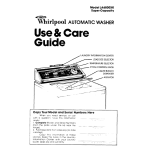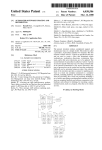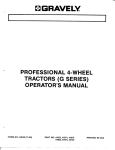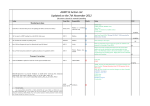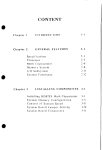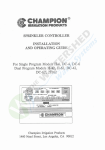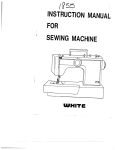Download White 1000 Sewing Machine User Manual
Transcript
INSTRUCTION MANUAL FOR 0 0 0 1 # E IN H C A M G IN W E S E L MA N U A L D E INSTRUCCION PARA COSER MAQUINA #1000 j WHITE IMPORTANT SAFETY INSTRUCTIONS precautions should always be When using an electrical appliance, basic safety folowed, including the following: Read all instructions before using (this appliance) DANGER To reduce the risk of electric shock: plugged in. Always unplug this An appliance should never be left unattended when and before cleaning. using after iately appliance from the electric outlet immed with same type rated 15 watts. Always unplug before relamping, Replace bulb WARNING To reduce the risk of burns, fire, electric shock, or injury to persons: is necessary when this appliance 1. Do not allow to be used as a toy. Close attention is used by or near children. ed in this manual. Use only 2. Use this appliance only for its intended use as describ ed in this manual. contain as acturer attachments recommended by the manuf if it is not working plug, or cord ed damag a has it if 3. Never operate this appliance d into water, Return the properly, if it has been dropped or damaged, or droppe for examination, repair, center appliance to the nearest authorized dealer or service electrical or mechanical adjustment. gs blocked, Keep ventilation open 4. Never operate the appliance with any air openin the accumulation of lint, ings of the sewing machine and foot controller free from dust, and loose cloth. g. 5. Never drop or insert any object into any openin 6. Do not use outdoors. being used or where oxygen is 7. Do not operate where aerosol (spray) products are being administered. n, then remove plug from 8. To disconnect, turn all controls to the off (“0”) positio outlet. the plug, not the cord. 9. Do not unplug by pulling on cord. To unplug, grasp required around the sewing is care l 10. Keep fingers away from all moving parts. Specia machine needle. wrong plate can cause the needle to break. ii. Always use the proper needle plate. The 12. Do not use bent needles. g. It may deflect the needle causing it to 13. Do not pull or push fabric while stitchin break. any adjustments in the needle area, 14. Unplug the sewing machine when making bobbin, or changing such as threading needle, changing needle, threading presser foot, etc. al outlet when removing covers, 15. Always unplug sewing machine from the electric ng adjustments mentioned in the servici user other lubricating, or when making any instruction manual. SAVE THESE INSTRUCTIONS ________ ________ POLARIZED PLUGS CAUTION This product is equipped with a polarized alternating current line plug (a plug having one blade wider than the other). This plug will fit into the power outlet only one way. This is a safety feature. If you are unable to insert the plug fully into the outlet, try reversing the plug. If the plug should still fail to fit, contact an electrician to replace the obsolete outlet. Do not defeat the safety purpose of the polarized plug. WHITE SEWING MACHINE COMPANY Record in space provided below the Serial No. and Model No. of this appliance. The Serial No. is located on Bed Plate. The Model No. is located on Rating Plate. Serial No. Model No. Retain these numbers for future reference. 2 CONTE NTS Name of Parts Accessories 1 2 Removing the extension table Before sewing (Power supply and Sewing amp) Fitting shank and Quilting seam gtiide. Fitting of presser feet Winding the bobbin Removing bobbin case and bobbin Inserting bobbin into bobbin case Inserting bobbin case into shuttle race Changing needle Threading upper thread & Twin needle threading Drawing up bobbin thread Changing sewing directions Adjusting.thread tensions . 3 4 5 6 7 7 8 8 9 10 10 11 Regulating the presser foot pressure 12 Darning plate 12 Fabric. Thread. Needle guide 13 Sewing (pattern selector) and operation table 14 To start sewing to finish a seam 15 Straight stitch zig zag stitch 16 Blind hemming 17 Three step zig-zag 18 Overcasting edges-binding 19 Straight stretch stitch 20 Sewinq on buttons 21 Sewing in zips 22 Button hole sewing 23 Hemming Twin needle-freehand embroidery. 24 . 25 - Cleaning of race .and shuttle hook. 26 Cleaning and oiling 27 Trouble shooting guide 28 a NAME OF PARTS (FRONT SIDE) 1 Pattern selector dial 2 Take up lever 3 Tread tension dial 4 Tread guide for upper threading 5 Presser foot 6 Shuttle cover 7 Extension table 8 Spool pin 9 Top cover 10 Stitch length dial 11 Reverse button 12 Bobbin winder spindle 13 Bobbin winder stopper 14 Stop motion knob 15 Hand wheel 16 Handle 17 Upper thread guide 18 Face cover 19 Thumbscrew 20 Needle plate 21 6 Needle clamp screw ACCESSORI ES Bobbin Felt Zigzag foot Button hole foot (On machine) Button foot Button hole cutter Machine Oil Zipper foot Screw driver Needle #11 7 #14 REMOViNG EXTENSION TABLE To convert the machine from flat-bed use to free-arm use simply remove the ex tension table as shown. FOR THE UNITED KINGDOM THIS IS ONLY APPLICABLE TO MACHINES MANUFACTURED IMPORT ANT code: The wires in this mains lead are coloured in accordance with the following BLUE — BROWN — NEUTRAL LIVE with the coloured NOTE. A the colours of the mains lead of this appliance may not correspond markings identifying the terminals in your plug, proceed as follows: Connect BROWN wire to terminal marked L or coloured RED. Connect BLUE wire to terminal marked N or coloured BLACK. FIT CORRECT PLUG TO POWER CORD FITTED. WHEN USING A B.S. 1363 FUSED PLUG. A 3 AMP. FUSE MUST BE before use. If the terminals of the plug are unmarked consult a qualified electrician socket outlet tM,en leaving the sewing machine unattended, the plug must be removed from the machine or the lamps, changing or covers removing when or machine, ‘Mien servicing the sewing the socket from the plug removing Supply by from the the electrical set must be disconnected outlet. THE MAXIMUM INPUT OF LAMP: 240 V 15 W. INTERFERENCE THIS APPLIANCE CONFORMS TO THE STATUTORY RADIO SUPPRESSION REGULATIONS. 8 BEFORE SEWING 1. Fit the machine pug into the machine. 2. Plug the machine to the power supply. 3. Sewing speed can be varied by the speed controller. FIT A TO SURE (BE CORRECT PLUG TO SUPPLY CORD) 1. Remove or install lamp from inside of face cover. 2. Open face cover in direction of arrow. 3. Rerncve lamp by unscrewing it counter clockwise. 4. Install a new bulb by screw ing it in clockwise. 15W 3. Use only a 120V • (Max) “Hi.Light’ brerd e placemert sewing machine lamp. Avalable from your Riccar stock ist Important: When leaving the machine unattended, servicing, changing lamps or removing covers, disconnect from the supply by removing plug from the socket outlet. 9 FITTING OF PRESSER FEET FITTING SHANK AND QUILTING SEAM GUIDE Raise the presser foot. Pull the one-touch lever towards you and the foot will be released. Centre new foot under shank. Raise the presser bar and fit shank as shown. (1) Insert quilting/seam guide carefully so as not to damage the holding spring. (2) Lower shank until groove is directly above and touching the pin. Pull onetouch lever towards you and the foot will become engaged. (3, 4) I Shank set strew Ti9hj Loosen Shank 4 10 WINDING THE BOBBIN 1. Release stop motion knob. 2. Thread as shown. 3. Place bobbin onto spindle and hand-wind thread onto bobbin in an anti-clockwise direction for 5 or 6 turns. (When bobbin is filled re-tighten stop motion knob) Bobbin 4. Push bobbin winder spindle against stopper, in direction of arrow, and depress foot pedal. 5. When bobbin winding is com pleted return spindle to its original position. Note: If the bobbin winding should be uneven (it is factory set) the thread guide can be raised or lowered to achieve the correct winding. Remove the top cover and adjust with a suitable tool. 11 REMOVING BOBBIN CASE AND BOBBIN Hinged 2. Open hinged latch of bobbin case and pull bob- 1. Raise needle to its highest position and open the bin case out of machine. shuttle race cover, 3. Release the latch and bob bin will fall out easily. INSERTING BOBBiN INTO BOBBIN CASE SLOT 1. Pull off 5cm of thread from bobbin and insert it into bobbin case as shown. 2. Guide the end of thread into slot. Tension spring 3. Pull into slot and under tension spring and draw out about thread. 12 10 cm of 7 INSERTING BOBBIN CASE INTO SHUTTLE RACE nse If Hinged latch —I 1. Ensure needle is at its highest position. Pulling thread to the front, open the latch of bobbin case and hold it. 2. Holding latch open, piace bobbin case onto centre pin in shuttle and release latch. CHANGING NEEDLE 1. Raise needle to its highest position. 2. Loosen needle clamp screw and re move old needle. 3. With the flat side of the needle facing away from you, insert needle as far up as it will go. 4. Tighten the needle clamp screw securely. Note: At the first sign of any stitching irregularity always change the needle for a new good quality one. 13 THREADING UPPER THREAD / / Thread the machine from A to G as illustrated. A. Through the thread guide. B. Between the tension discs. C. Up and into the tension spring. D. Into the thread take-up ever from right to left. E. Down behnd the thread guide. F. Behind the needle clamp thread guide. BJ G. Through the needle from front to back Fig. 1 & 2 also illustrates threading for twin needle sewing (see page 25) G 14 .2 ( DRAWING UP BOBBIN THREAD Hoid the top thread with a slight tension ri your left hand and rotate the hand wheel towards you so that the needle goes down and up again, then gently pull your thread out towards the rear and under your sewing foot and you are ready to start sewing. I 4 CHANGING SEWING DIRECTIONS 1. Lower needle down into fabric and raise presser foot, pivot the fabric around the needle to change direction as desired. 15 2. Put down presser foot and start to sew. ADJUSTING UPPER THREAD TENSION It is only normally necessary to adjust the upper thread tension to achieve the correct balance between the upper and lower threads. The higher the number on the dial the greater the tension. S Correct Incorrect Inside of fabric Upper thread Fabric Upper thread Bobbin thread THREAD LOWER ADJUSTING TENSION Lower thread tension can be adjusted by turning the screw on the bobbin case slightly to the right (clock-wise) to increase tension, (Anti-clockwise) to the to decrease tension. As a general guide only, the user can achieve the correct tension for normal sewing, by carefully susncriding the wound bobbin in its case by the thread. If the bobbin and case immediately fall to the ground, the tension is too loose and should be increased. The correct tension is obtained when a slight jerk of the thread causes the bobbin to drop a short distance only. If this action does not move the bobbin the tension is too tight and should be loosened until the desired effect is achieved. 16 Increase Decrease REGULATING THE PRESSER FOOT PRESSURE / —7——- ‘B r€QJJ2or N - To release the pressure, push ring (A) downwards. This causes the regulator to spring up to its highest position. The material is now free from any pressure of the presser foot. For sewng thin or light materials, push regulator (B) down just a little to provide the light pressure required. If you are sewing thick or heavy materials, push the regulator (B) farther down to increase the pressure on the material. DROP FEED !‘ Lower feed dog by pushing lever, down n directon of arrow (No feeding of fabric) Used when sewng on buttons, free hand embroidery etc. For general sewing, ra!se height of feed dog direction of arrow. 17 by lifting lever in FABRIC THREAD NEEDLE GUIDE Length of stitches \ Fabric \\ Thread Needle Pressure of presser foot Pressure regulation \o Nylon 80 Cotton Tricot 605. Fibe Silk 50 silk ST. ZZ. Indica of tension Stitch length t a I Light \\\ 50S.Fibe Wool silk Silk Medium Gingham 11 0.5-3 11 60-80 Cotton or E 1 0.5-3 hinJerse6QSFibe 0.5-4 0.5—4 5 14 Gabardine 50 Silk Heavy ‘\\ Denim 50 cotton 14 Jersey 50 S. Fibei 14 Tweed 50 Silk 14 1—4 0.5—5 th on finer fabrics and longer stitch leng As a general rule use shorter stitch lengths arii d with finer fabrics and heavier threa with heavier fabrics, finer thread and needles point’ or ‘stretch’ needles on difficul ‘ball needles with heavier fabrics. Use special stretchy fabrics. 18 4 I E R) AND OPERATION TABL SEWING (PATTERN SELECTO Stitch Setch Length Presser Foot Stitch Patterns Straight Stitch 1 Drop !ecd 1 • 1 ZZag 2 B i nd Hem • - j2 > Thread step-Zigzag Stitch 3 Slant Overedge Straight Stretch Stitch 5 Button Hoie 6 Twin Needle 1 4 exCept Freehand Embroidery buttOn hce — . [f Not Necessary I 19 SELECTOR) AND OPERATION TABLE SEWING (PATTERN 20 TO START SEWING Important Hints. 1. 2. 3. 4. 5. position when starting and stopping Raise the take-up lever to its highest sewing. rear of machine for the first two or Hold both threads about 10 cms to the three stitches. before lowering presser foot. Sufficient fabric should be placed under needle Depress foot/Speed control and start to sew. you plan to use, adjusting the Test the machine stitches on a scrap of fabric on suitable to your fabric. machine for the length of stitch and tensi Attention. 1. 2. 3. turn it toward you. When turning the hand wheel manually, always Guide the cloth gently with your hand. the needle out of the fabric. To prevent breaking needle always stop with TO FINISH SEAM I ii ii 1. Sew to the edge of seam. 2. Push the reverse button and sew in reverse for about 2—3 cms. 3. Raise needle to its highest position. 4. Lift presser foot and pull out the fabric to rear of machine. 5. Cut threads, as shown, on the thread cutter. 21 STRAIGHT STITCH While ‘2” or “3” on the dial gives a suitable stitch length for ordinary purposes, the stitch length varies with the weight of fabric, thickness of thread and pur poses, the stitch length varies with the weight of fabric, thickness of thread and purpose of sewing. Generally speaking, the finer the fabric, the finer the thread and shorter the sttch length; the heavier the fabric, the thicker the thread and longer the stitch length. 4 I I 3 2 I 0_s 0 the At “0” the fabrc will not move anead, and me neede will keep percng same point. ZIG-ZAG STITCH The zig-zag stitch can be set at various sttch widths and engths according to the application required. Set the pattern selector as desir J. HHt Satin stitching is a “closed up”, very short stitch length, stitch and can be used for sewing initials, patterns, applique, etc. 22 /7 I I BLIND HEMMING the “wrong” side facing upwards.(1) Fold the fabric as illustrated with I foot as shown. Place the folded fabric under the the hand, urtil the needle swings over to Turn the hand wheel towards you by not then e the fold of the fabric. (2( If it does far left. It should then just pierc adjust the position of the fabric. c has been set, position the “guide” of the Once the correct position of the fabri turning the nut (4). foot (3) up against the fold (2) by posi fabric to ensure it retains the correct Proceed to sew carefully feeding the best the in e practice will be needed to obta tion against the guide. (3) Note: Som spare piece of fabric. results. Always test the stitch first on a 2 I J 23 :1 THREE STEP ZIG-ZAG The three step zig-zag stitch has a wide range of sewing applications, such as patching, darning, repairing tears, mending, sewing on elastic and lace, oversew ing edges etc. on a wide range of fabrics. The illustration shows patching, where the stitches are to the edge of the patch and a tear, where the stitches go firstly over the centre of the tear and then to either side but overlapping slighly on the first row. The stitch length can be reduced until the stitches are very close together. This will give a stronger finish for most repairing operations. :: 24 4 OVERCASTING EDGES For thicker fabrics Both these stitches are designed to overlock the edge of a fabric. When the needle is at its extreme right position, aflow it to just pass over or just pierce the edge of the fabric according to the effect you require. Using the overcasting foot will prevent puckering of thin fabrics. I BINDING 25 STRAIGHT STRETCH STITCH The straight stretch sews two stitches forward and one stitch backwards, thereby giving “triple” strength. Use it for stretch fabrics and for areas of “stress” where a strong stitch is required. Ill II ill ill II Ii Iii 26 I SEWING ON BUTTONS 1. Fit darning pate as described on page 12. 2. Use button presser foot and attach firmly 3. Place button between presser foot and fabric and lower presser foot. 4. Manuaily turn hand wheel towards you ensuring that the needle enters into both holes of button without obstruction. (Increase or decrease width settng(. 5. Sew about 7 stitches. 6. Pull both threads to the underside and tie together. 27 SEWING IN ZIPS Ft the Zipper foot. The Zipper foot can be moved to the left or right. (2) To sew on the right hand side of the zipper, move foot over to the right as illustrated and reverse the procedure to sew the left hand side of the zipper. (3) raise foot To move the “zip slider” out of the way, leave needle in the fabric, ue. contin and foot the Lower foot. the and slide it behind 28 /7, BUTTON HOLE SEWING Ft the button hole foot. Set the s:tch length dial within the green marking to achieve the correct density (closeness) of satin sttch. (1) Sew in the sequence illustrated (1) selecting patterns 18, 19, 20 and 19 again. USER TIPS Always sew a sample buttonhole on some spare fabric as settings will change according to the fabric used. For very thin, stretchy or other difficult fabrics, try using interfacing (vilene) or tissue or other paper underneath the fabric to aid machine feeding. Always use the Buttonhole foot using its calibrated markings to measure the buttonhole length. On suitable fabric, a corded buttonhole can be sewn taking care that the zig-zag stitches of the buttonhole oversew the cord. (2) Carefully cut between the sIdes (beads) of the buttonhole with the seam ripper using a pin through the end bar tack (2) to prevent the seam ripper going too far. The top tension may be reduced to achieve a better looking buttonhole. 29 j HEMMING y n. Replace the foot with the 1. Raise the foot and the needle to its highest positio hemmer foot. place it under the foot. Secure the 2. Fold over the fabric edge by about 3mm and and draw the hem folded edge with a few stitches. Take out the workpiece into the hemmer foot by pulling the threads. 3. Lower the foot and sew the hem. the 4. During sewing, fold the fabric to the left a little and allow it to run info hemmer foot. The 5. Make sure that the fabric does not move under the right half of the foot. fabric must be fed into the scroll of the hemmer sufficiently so that the workpiece edge runs freely through the groove under the foot. acheive Only suitable materials can be used and some practice may be necessary to best results. 30 ( TWIN NEEDLE the threads Thread machine as for normal sewing using both spool cins and pass le. need of each eye gh the e throu but edur through the same proc h :vlath eAceedEng NB. Sewng width shouid not exceed the third wdest stitc this will result n breakinc of needles. Suitable for stitch numbers 1, 2, 3 and 13 only, FREEHAND EMBROIDERY mc encall controilec sutohng fedinc In freehand embroidery, unlike mech from feed dogs. faoric is done by hana without assistance 12 and set sltch patterns from 15 as Fit darning plate as described on page desired. used. Use wooden or plastc hoops witn A round embroidery hoop Es generally an adjusting screw. Stretch the fabric tghl accross the hoop and sew wnUst moving the hoop to create the desired effect. 31 CLEANING OF RACE AND SHUTTLE HOOK Raise the needle bar to its highest point by turning the hand wheel toward you. Open shuttle cover. 1) 2) 3) 4) Take out the bobbin case. Unlock the shuttle race holder. Release the shuttle race cover. Take out the shuttle hook Clean dust and gummed oil off each part with an oiled cloth. When finished cleaning, reassemble reversing the above procedure. Shuttle race cover Bobbri case Shuttie race hoder Shuttle ‘ook Shittle race cover Shuttle hook 32 c. cz CD C a CD 0 0 a CD Ct, C D 0. 0 a Ct, C, :3 V 0 :3 0 7- (13 0) C, :3 a V 0 0 :3 a. CE, 0 C-) -o 0 :3 CE, V 0 (C, 0 a a (13 (13 (C, 3 :3 Co 0) C) z 0 z z z m C) 4 Needle is donaged. 5. Maiiiine requires servicing 2 Bobbin case is improperly threaded 3 Bobbin tension is too ighi I Needle is not inserted comiertly 2 Needle is damaged 3 Wrong type of niemfle is used 4 Wiong foot is used 5 Foot pressure us wrong 1 Needle is dimniageil 2 Nreifle is riot uisn-rteif ( ommei ly 9 niredle size 3 oLin ii too heavy / wr on 4 F ahr i is being I uI Icrl fiy ripen oton S Wi orig sewr rig foot is usucf Needle is not tfnn coded coiner tly 2 Bobbin us not threaded correctly 3 Needfe/fobn it/thread rotio is incorrect 4 Incorrect tenusicins foot pressure is too fiecivy 2 Needle is too lam jr fi fnrlim it 3 Wiong stitch fengili is used 4 Tension is too heavy Threod is poor quality of Fool pressure is 100 light ed incorrectly t Bobbin is thieoc Moteiiol is being pulled by operator I Mac hint needc c,,l 2 tint and oil residue hose collected in hook or on needle bar 3 Inferior oil has been used and gums-up mochine CAUSE I Machine is threaded incorrectly. 2. Tension is too tight 3 Thread is too heavy for needle sire, 4. Needle is inserted incorrectly 5 Thread may he caught on reel holder 6 Needle is darriaged I Bobbin case is riot inseitcd correctly TROUBLE-SHOOTING GUIDE CONDITtON To p thread breaks Lower thread breaks Skipped stitches Needle break age I or S I OOPS h S or pucker Seams chink Irregular stitching/feeding Machine is noisy and rough REMEDY_________________ 1. Rethreod machine and needle 2 Reduce tension on top (smaller numbers). 3. Use forger needle 4 Reinsert needle (flat side toward bock). 5. Remove spoof, rewind excess thread 6 tmrsertnew needle. I. Reposition bobbin. Check by pulling thread. If it pulls smoothly it is correct 2 Check for correct threading 3 Chonge bobbin tension according to instructions. 1 Reinsert needle (flat side toward bockL 2 Insert new needle 3 Makfi rieeille size to fobrrc nnd threod weight. 4. Check to see if proper sewing foot i used. 5 Check foot pressure regulation for proper setting I ricer t new needle. 2 Reinsert niecifle correctly (flat side toward bock( 3 Mrrk hi riced Ic size to thin ecnd & fabr it weiglnt 4 I)o not pull nun cloth. C heck (or proper foot pr essure 5. lice correct foot 1. Tfireod needle front to back 2 Threod bobbin according to chart 3. Match needle size to thread & fabric weight 4. Set correct tensions I Reduce foot pressure (smaller rrumnnbens(. 2. Use smaller needle. ust length for proper stitches 1 3 Ad 4(hec k terssnomss I Use quality thread! 2. Increase foot pressure (lorger numbers). 3. Thread bobbin again and check for proper insertion. 4Do not pull on fabric Let it feed automatically. 9 to iiitr ut tionS Oil crccordi mm 7 race and hook according to irrstructions. Clean 3 Clean and oil again only with fine sewing machine oil (rmot 3-in-! oil) 4 Replace needle 5. Consult your specialist deafer.

































